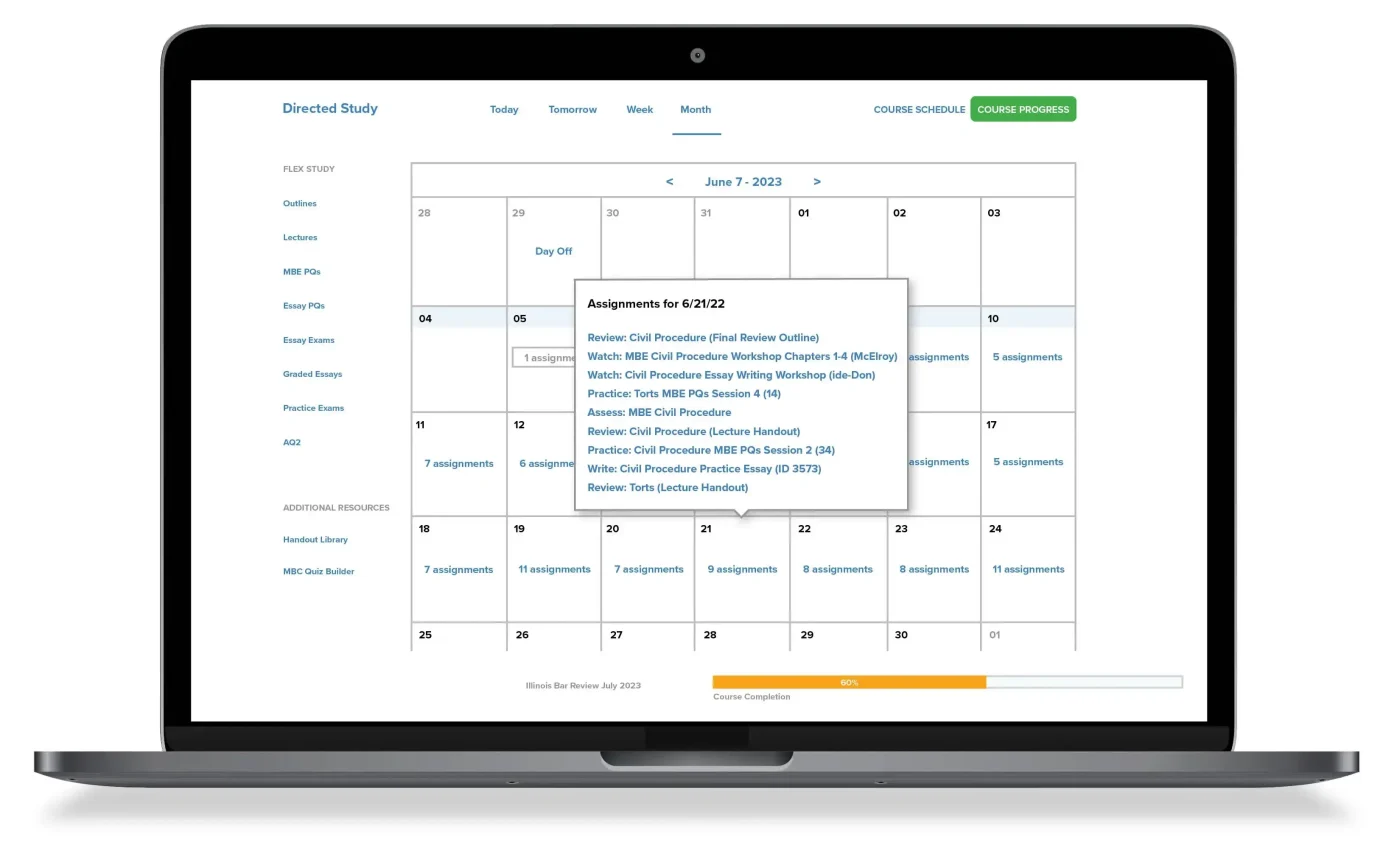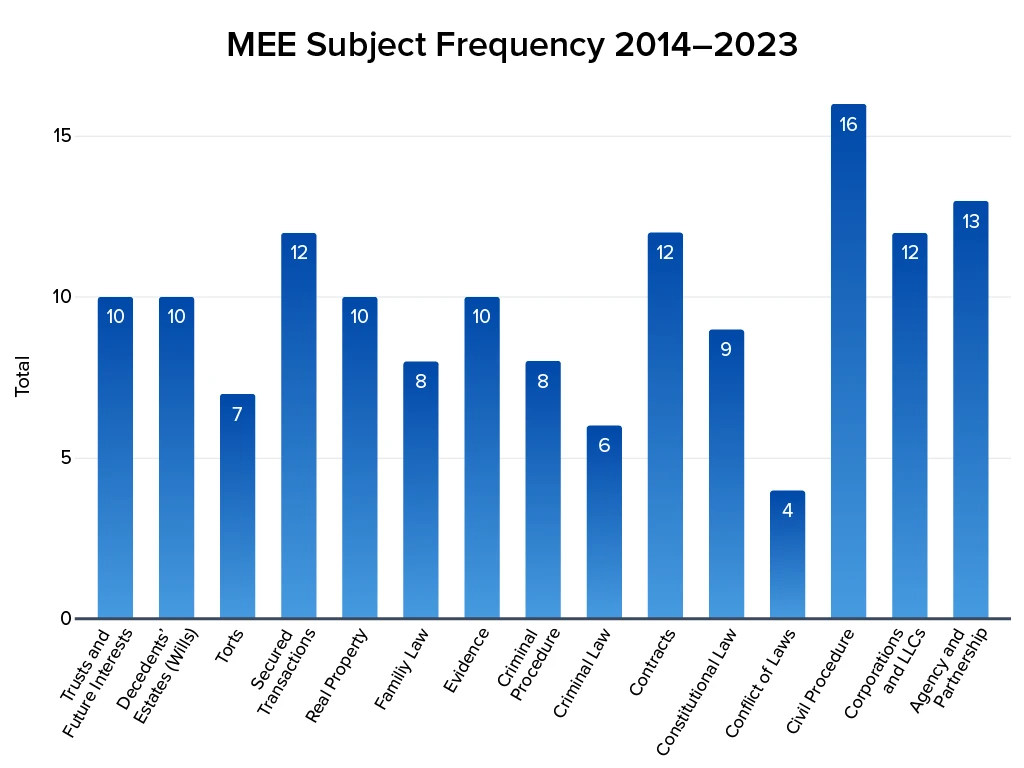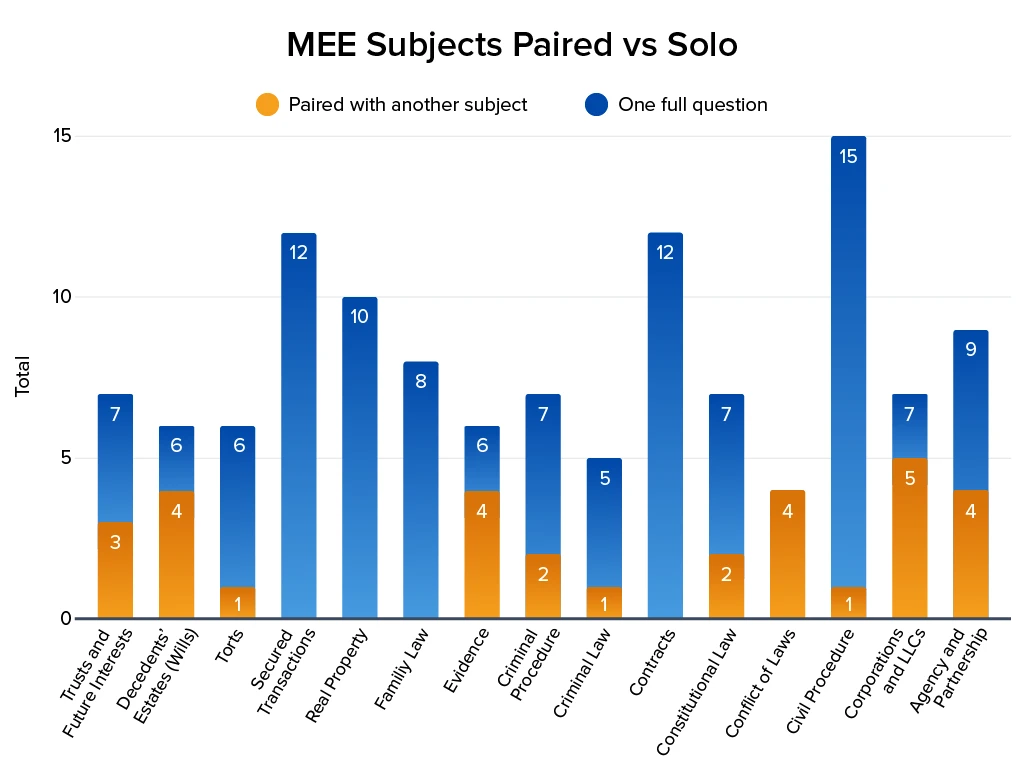MEE® Study Guide
Improve Your Score and Pass the Bar Exam
Many first-time examinees assume they just need to master all requisite knowledge to ace the essay component of the bar exam. While memorizing the material doesn't put you at a disadvantage, taking an active learning approach by writing practice essays straight away is a more efficient strategy.
The following Multistate Essay Examination (MEE®) study guide provides a blueprint that has helped many hopeful examinees meet or exceed their goals. We will discuss how to study for the MEE and cover the best study materials and aids available.
Understand the MEE Format, Grading, and Subjects
The National Conference of Bar Examiners (NCBE®) administers the MEE to test one's ability to communicate a reasoned analysis of relevant legal issues in essay form. It contains 6 essay questions and is administered over a 3-hour session.
Details vary for non-UBE jurisdictions. For example, Part 1 of Louisiana's bar exam primarily includes essay questions but may have a mix of multiple-choice questions. However, most jurisdictions have adopted the UBE, which follows the grading method, format, and subject breakdown below.
MEE grading
The MEE constitutes 30% of the total weight of the Uniform Bar Exam (UBE®). This varies for non-UBE jurisdictions, which typically assign the essay portion a weight between 30% and 45%.
Grading scales vary by jurisdiction, but each essay answer is scored on a scale from 0-6 on the UBE. To ensure fairness, bar exam graders compare a "calibration packet" of 30 student papers and rank-order them according to predetermined criteria. This is known as relative grading.
For example, a “6” conveys that your essay answer indicated a thorough understanding of the law and an ability to communicate rationally and that it was among the most impressive relative to others. In contrast, a 0 is typically given when there is no response. A "1" signals that an essay answer was among the worst in the calibration packet and showed little indication of reasoning, communication skills, or an understanding of the law.
Your final score will not be between 0 and 36 (6 essays, 6 points each) because raw scores are converted into scaled scores.

MEE format and subjects
The MEE tests examinees on a number of rules of law and legal concepts pulled from a pool of 12 subjects. Since there are only 6 questions, some subjects will be omitted. However, you may come across a question that pairs 2 subjects together. Therefore, although there are only 6 questions, you may be tested on 7 or more subjects.
All UBE jurisdictions use NCBE-administered MEE questions pulled from 12 possible subjects. They are:
- Business Associations
- Civil Procedure
- Conflict of Laws
- Constitutional Law
- Contracts
- Criminal Law and Procedure
- Evidence
- Family Law
- Real Property
- Secured transactions
- Torts
- Trusts and Estates
The frequency with which subjects appear varies by exam. See the section below for information regarding which subjects are more heavily tested, or visit our MEE Subjects page for summaries of each.
How to Study and Prepare for the MEE
Whether or not you pass the MEE ultimately comes down to how well you study and prepare. There are effective, efficient, and tested methods to improve your score. The following sections provide actionable tips for MEE preparation and relevant tools to help you implement them.
Memorize and understand black letter laws
Blackletter law is a fundamental and well-established set of legal rules. Memorizing and understanding the legal rules will give you a serious advantage on the MEE. Many students go into the exam with a passing familiarity with the rules of law, believing they'll be able to spot issues easily. These are the students who typically fail. The difference between being familiar with blackletter laws and having them firmly impressed in your memory is the difference between bar exam success and failure.
Use spaced-repetition flashcards
Spaced-repetition flashcards are an effective way to memorize blackletter laws. This method is the opposite of cramming. Spaced-repetition flashcards present material at systemic intervals. New flashcards are presented at shorter intervals (e.g., 1 hour, 5 hours, 1 day), and these intervals increase based on how you grade your understanding, with easier, more familiar material being shown less frequently.
For example, say you create a flashcard containing material on "subject matter jurisdiction," a frequently tested Civil Procedure topic on the MEE. An hour later, the spaced-repetition software presents that flashcard. You don't understand the material, so you grade it as “difficult”. Then you see it 4 hours later, 8 hours later, and by the 12th hour, you're starting to get it, so you grade it as "average." Now, you may see this card every other day until it becomes easier, and the process continues.
Without spaced repetition, you might study Civil Procedure in your first week of study and forget everything 10 weeks later on the bar exam. The spaced-repetition method allows you to have mixed exposure to various topics throughout your study.

Improve your issue-spotting skills
Knowing blackletter law is the first step to improving your issue-spotting skills. Issue spotting is the ability to use facts in a fact pattern to discuss the relevant law. For the MEE, this will be the law relevant to the question at hand. If you can't identify the issue, you'll lose points. More importantly, the rationale of your answer will suffer.
Checking the call of the question first will help you navigate complex fact patterns, write a focused answer, and become a better issue spotter. Familiarize yourself with the call of the question from past bar exams. Check out the NCBE's past Free MEE Questions and Analyses from Older Administrations (scroll to the bottom of the page) and this MEE question on Decedents Estates from the February 2023 UBE.
Some final advice on issue spotting—understand hypotheticals. This refers to the hypothetical "factual" situations presented in the question. The NCBE has administered dozens of MEEs, and there are only so many ways to test a subject. By exposing yourself to as many past hypotheticals as possible, you'll start to recognize patterns. But exposure is not enough. You need to practice responding to the hypotheticals and then get feedback.
Practice with the active learning method
Taking an active learning approach is the best way to practice writing essays. Active learning is about faithfully imitating the actual exam's substance, form, and conditions. That's why it's important to start writing practice essays with exam-level MEE questions as soon as possible.
Practice essays will train your issue-spotting skills while helping you identify your blind spots. As you practice, create outlines or mind maps with undefined keywords and phrases for review and follow an issue-spotting checklist to build good habits.
Make a study schedule/plan
Passing the MEE may seem more difficult than it really is when viewed as a singular, one-step goal. You'll be less stressed and better prepared by breaking your overarching goal of "passing the MEE" into manageable and realizable mini-goals. Estimate the hours you'll need to study the most heavily tested subjects, and be realistic and consistent as you block the requisite time into your schedule.
When you sign up for the Themis + UWorld Bar Review Bundle, you'll gain access to our adaptive study calendar that adjusts your study schedule based on your selected start date. The Progress Monitor tracks your performance so you always know which subjects you should be studying, when you should be studying them, and for how long.
Don't worry about calculating how much you need to study or waste time tracking down what you missed. Your calendar does that for you. Simply set your date and start studying.
Know which subjects are heavily tested
There is no way to know precisely which MEE subjects you'll confront on your exam version. Therefore, you should study every topic thoroughly. If you're short on more time, target more heavily weighted topics unless your understanding of them is solid.
For example, the following subjects were tested on the July 2023 bar exam:
- Agency & Partnership test with Corporations & LLCs
- Civil Procedure
- Criminal Procedure
- Torts
- Trusts & Future Interests
- Secured Transactions
However, in February 2023, these subjects were tested:
- Civil Procedure
- Criminal Procedure
- Decedents' Estate (Wills)
- Evidence
- Real Property
- Secured Transactions
An examinee who failed the UBE in February and retook it in July would only be tested on different subjects. While we can't be certain which subjects will be tested, we can look at historical data to determine what's most likely. For example, "Civil Procedure" is almost always tested, while "Conflict of Laws" has only been tested 4 times over 20 exam versions and has always been tested with another subject.
Fortunately, the charts below provide the frequency with which each subject appears on the MEE. You'll notice that the "Business Associations" and "Trusts and Estates" subjects each contain two sub-categories.
Our table begins with the February 2014 exam because the NCBE formerly released 9 MEE questions, and participating jurisdictions would choose 6. In the years since the NCBE has only released 6.
While the NCBE lists certain subjects as one subject, they can be broken down and tested separately on the exam. For example:
- Business Associations — Corporations and LLCs; Agency and Partnership
- Trusts and Estates — Descendants Estates; Trusts and Future Interests
- Criminal Law and Procedure — Criminal Law; Criminal Procedure
Refer to the chart below to see how often a subject has been tested versus how often it's been paired with another subject.
Use this data as you design your study schedule. While you may see rare "Conflict of Laws" questions, it would be wise to focus more time studying "Civil Procedure" if you're short on time and your understanding of each is similar.

How Long Should You Study for the MEE?
The time you need to study for the MEE largely depends on your academic background, how well you already understand the material, and whether you are studying full-time or with a full-time or part-time job.
Studying full-time
We typically recommend that students begin studying approximately 8-10 weeks (2-3 months) before the date of their bar exam if they can study full-time. With this timeline, you can study 40-50 hours a week.
You'll have to study one to two MEE subjects per week while reviewing the subjects you've already studied as you get closer to the exam.
Studying with a full-time job
If you have a full-time job, a family, or other responsibilities that would keep you from studying for 40-50 hours a week. We recommend that you begin 4-6 months before your exam. This timeline will give you 16-25 hours a month to study for the MEE, enough time to study 1 subject every week.
MEE Preparation Tips to Improve Your Score
Students studying for the MEE should think about answering each question as if they're solving a math problem. Being clear, concise, and showing every step of your work will help you gain maximum points on each essay.
Use paragraph breaks and headings
Bar examiners will be more likely to award you all the points you deserve if you structure your answers in an easy-to-read way. Using a clear header and breaking each answer into sections makes it easier for the reader to understand exactly what they're looking at.
Use the facts
Always include all relevant facts in your MEE answers. Using the facts to back up your analysis and conclusion ties your answer together.
Self-grade your practice MEE
Use the sample answers provided in your bar review course to self-grade and submit all of your graded essays for review. The more feedback the better.
Use IRAC
Structure your answers using the IRAC method: Issue, Rule, Analysis, and Conclusion. This makes your answer clear to the reader and ensures that you're not omitting any important information.
Raise Your MEE Score with the UWorld Study Methodology
UWorld's study methodology is based on the active learning method. Research has shown that active learning is superior to passive learning in increasing retention and improving exam performance. This research has shown that when multiple neural pathways are activated simultaneously, they make new connections more efficiently. The more stimulating the activity, the more efficient the learning process becomes.
For example, it's obvious to anyone that practicing soccer is a more effective way to learn soccer than listening to a lecture about the game. The same is true for exams. Our product covers every section of the learning pyramid, but focuses on the areas with the highest return on investment.
The following tools are how the Themis + UWorld Bar Review Bundle implements our active learning methodology for the MEE:
- 100+ essays from past bar exams
- Essay skills workshops that teach techniques for every subject
- Unlimited essay grading from attorneys and bar exam experts



